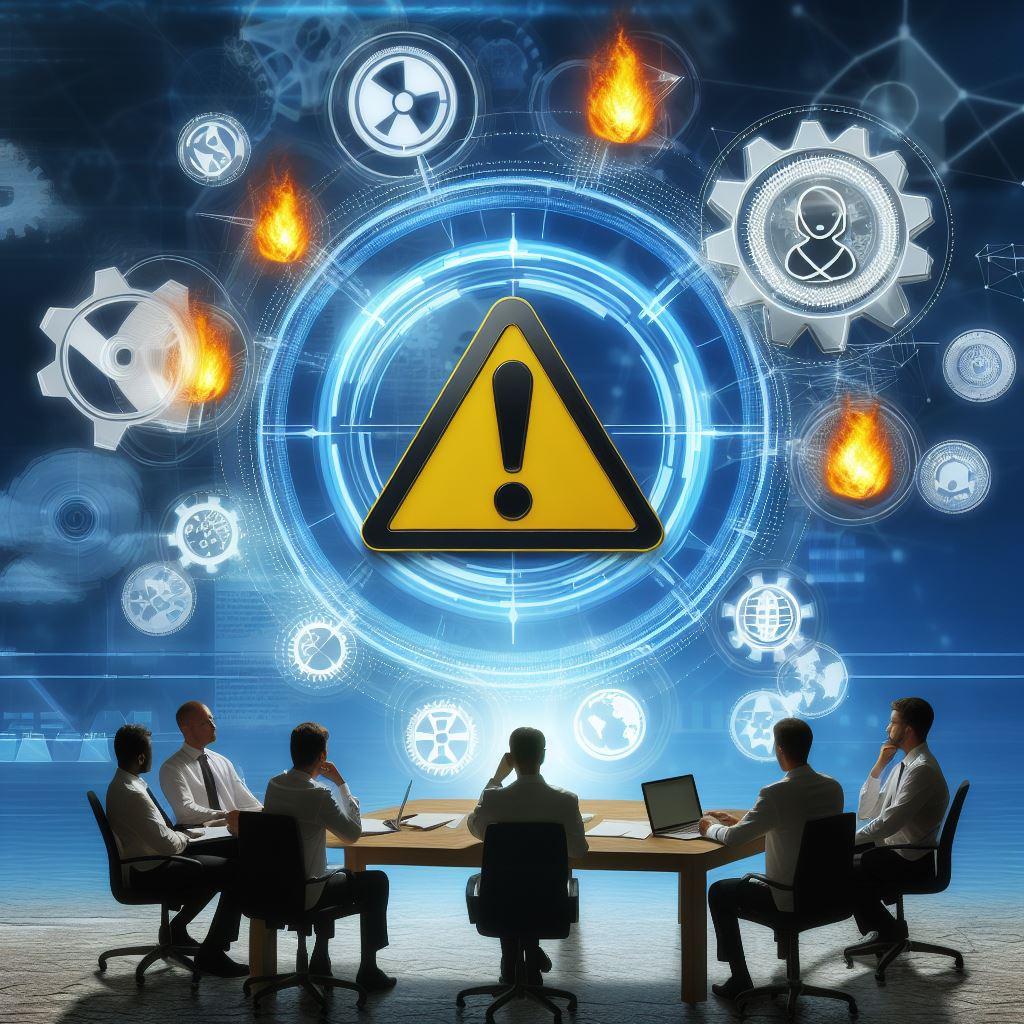In today’s rapidly changing business landscape, organizations must navigate through various types of change, such as technological advancements, market shifts, and organizational restructuring. However, change also brings inherent risks that can have significant impacts on a business’s success. Therefore, it is crucial for businesses to understand and manage these risks effectively. This is where risk assessment comes into play. By conducting thorough risk assessments during times of change, businesses can identify potential risks, assess their likelihood and impact, develop risk management plans, and ultimately minimize negative consequences. In this article, we will explore the importance of risk assessment in navigating change and provide practical strategies for businesses to manage risks effectively.
Key Takeaways
- Risk assessment is crucial in navigating change.
- Potential risks in times of change must be identified.
- The likelihood and impact of change-related risks must be assessed.
- A risk management plan must be developed for change.
- Risk assessment findings must be communicated to stakeholders.
Understanding the Importance of Risk Assessment in Navigating Change
Risk assessment is a systematic process of identifying, analyzing, and evaluating potential risks associated with a specific change or project. It plays a vital role in change management by helping businesses understand the potential risks they may face and develop strategies to mitigate them. Without proper risk assessment, businesses may be caught off guard by unforeseen risks, leading to costly mistakes and negative impacts on their operations.
Conducting risk assessments during times of change offers several benefits. Firstly, it allows businesses to proactively identify potential risks and take appropriate measures to mitigate them. By understanding the risks involved in a particular change initiative, businesses can develop contingency plans and allocate resources accordingly. This proactive approach helps minimize disruptions and ensures smoother transitions.
Secondly, risk assessments enable businesses to prioritize risks based on their likelihood and impact. Not all risks are created equal; some may have a higher probability of occurring or a more significant impact on the organization’s objectives. By assessing the likelihood and impact of each risk, businesses can prioritize their efforts and focus on managing the most critical risks first.
Lastly, risk assessments provide businesses with valuable insights into the potential consequences of change-related risks. This knowledge allows organizations to make informed decisions about whether to proceed with a particular change initiative or modify their plans to minimize potential negative impacts. By understanding the potential consequences, businesses can make strategic choices that align with their overall objectives and minimize the likelihood of failure.

Identifying Potential Risks in Times of Change
Identifying potential risks is a crucial step in the risk assessment process. During times of change, businesses face various risks that can impact their operations, financial stability, reputation, and overall success. To identify potential risks effectively, businesses should adopt a systematic approach that involves engaging stakeholders, conducting thorough research, and analyzing historical data.
Engaging stakeholders is essential because different perspectives can help identify risks that may not be immediately apparent. By involving employees, customers, suppliers, and other relevant stakeholders in the risk identification process, businesses can gain a comprehensive understanding of the potential risks they may face.
Thorough research is another critical component of identifying potential risks. Businesses should conduct market research, industry analysis, and internal assessments to identify external and internal factors that could pose risks during times of change. This research should include factors such as technological advancements, regulatory changes, competitive landscape shifts, and customer preferences.
Analyzing historical data is also valuable in identifying potential risks. By reviewing past change initiatives and their outcomes, businesses can identify patterns and trends that may indicate potential risks in future change initiatives. This analysis can help organizations learn from past mistakes and make more informed decisions about managing risks.
Common risks that businesses may face during times of change include:
1. Financial Risks: Changes in market conditions or economic downturns can impact a business’s financial stability. These risks may include increased costs, decreased revenue, or difficulty accessing capital.
2. Operational Risks: Changes in processes, systems, or organizational structure can lead to operational disruptions. These risks may include delays in production or service delivery, decreased productivity, or increased errors.
3. Reputational Risks: Changes in branding, marketing strategies, or customer experience can impact a business’s reputation. These risks may include negative publicity, customer dissatisfaction, or loss of trust.
4. Regulatory Risks: Changes in laws, regulations, or compliance requirements can pose risks to businesses. These risks may include fines, penalties, or legal disputes.
5. Human Resources Risks: Changes in workforce dynamics, such as layoffs, relocations, or restructuring, can impact employee morale and productivity. These risks may include increased turnover, decreased engagement, or difficulty attracting and retaining talent.
Assessing the Likelihood and Impact of Change-Related Risks
| Risk | Likelihood | Impact |
|---|---|---|
| Resistance to change | High | Medium |
| Insufficient communication | Medium | High |
| Scope creep | High | High |
| Resource constraints | Medium | Medium |
| Technical difficulties | Low | High |
Once potential risks have been identified, it is essential to assess their likelihood and impact. This assessment helps businesses prioritize their efforts and allocate resources effectively. Assessing the likelihood and impact of change-related risks involves analyzing various factors and using qualitative or quantitative methods.
To assess the likelihood of a risk occurring, businesses should consider factors such as historical data, industry trends, expert opinions, and internal assessments. By analyzing these factors, businesses can estimate the probability of a risk materializing. This estimation can be expressed as a percentage or a qualitative rating (e.g., low, medium, high).
To assess the impact of a risk, businesses should consider factors such as financial implications, operational disruptions, reputational damage, and legal consequences. By analyzing these factors, businesses can estimate the potential consequences of a risk materializing. This estimation can be expressed as a monetary value or a qualitative rating (e.g., low, medium, high).
Once the likelihood and impact of each risk have been assessed, businesses can prioritize their efforts based on the level of risk. Risks with a high likelihood and high impact should be given the highest priority and receive more attention in the risk management plan.
Developing a Risk Management Plan for Change
Developing a risk management plan is crucial for effectively managing change-related risks. A risk management plan outlines the strategies, actions, and resources required to mitigate risks and minimize negative consequences. It provides a roadmap for businesses to follow during times of change and ensures that risk management efforts are coordinated and consistent.
When developing a risk management plan, businesses should consider the following key components:
1. Risk Identification: Clearly identify and document all potential risks associated with the change initiative. This step ensures that no risks are overlooked and provides a comprehensive view of the potential challenges.
2. Risk Assessment: Assess the likelihood and impact of each risk to prioritize efforts and allocate resources effectively. This step helps businesses focus on managing the most critical risks first.
3. Risk Mitigation Strategies: Develop specific strategies and actions to mitigate each identified risk. These strategies may include implementing controls, developing contingency plans, or seeking insurance coverage.
4. Risk Monitoring: Establish a process for monitoring risks throughout the change initiative. Regular monitoring allows businesses to identify any changes in risk levels or new risks that may arise during the course of the project.
5. Communication Plan: Develop a communication plan to ensure that stakeholders are informed about the identified risks, mitigation strategies, and progress in managing risks. Effective communication helps build trust and ensures that everyone is on the same page.
6. Resource Allocation: Allocate appropriate resources, such as budget, personnel, and technology, to support risk management efforts. Sufficient resources are essential for implementing mitigation strategies effectively.
7. Review and Update: Regularly review and update the risk management plan as needed. Change is dynamic, and new risks may emerge or existing risks may change over time. Regular reviews ensure that the risk management plan remains relevant and effective.
Communicating Risk Assessment Findings to Stakeholders
Communicating risk assessment findings to stakeholders is crucial for effective risk management during times of change. Stakeholders include employees, customers, suppliers, investors, regulators, and other individuals or groups who have an interest in or are affected by the change initiative. Effective communication helps build trust, manage expectations, and ensure that everyone is aware of the potential risks and mitigation strategies.
When communicating risk assessment findings to stakeholders, businesses should consider the following tips:
1. Tailor the message: Adapt the communication style and language to suit the needs and preferences of different stakeholders. Some stakeholders may require technical details, while others may prefer a more high-level overview.
2. Be transparent: Provide accurate and honest information about the identified risks, their likelihood and impact, and the proposed mitigation strategies. Transparency builds trust and ensures that stakeholders have a realistic understanding of the potential challenges.
3. Use visual aids: Utilize visual aids, such as charts, graphs, or infographics, to present complex information in a clear and concise manner. Visual aids help stakeholders grasp the key points quickly and facilitate better understanding.
4. Provide context: Explain how the identified risks align with the overall objectives of the change initiative. Providing context helps stakeholders understand why certain risks are prioritized and how they may impact the organization’s goals.
5. Encourage feedback: Create opportunities for stakeholders to provide feedback, ask questions, or express concerns. Encouraging open dialogue fosters collaboration and allows businesses to address any misconceptions or uncertainties.
6. Follow up: Regularly update stakeholders on the progress of risk management efforts and any changes in risk levels or mitigation strategies. Following up demonstrates accountability and ensures that stakeholders are kept informed throughout the change initiative.

Mitigating Risks and Minimizing Negative Consequences of Change
Mitigating risks is a critical step in managing change effectively. By implementing appropriate strategies and actions, businesses can minimize negative consequences and ensure a smoother transition. There are various risk mitigation strategies that businesses can employ depending on the nature of the risks they face.
1. Implement Controls: Implementing controls involves putting measures in place to prevent or minimize the occurrence of risks. For example, businesses can implement quality control processes to minimize the risk of product defects or establish cybersecurity measures to protect against data breaches.
2. Develop Contingency Plans: Developing contingency plans involves creating alternative courses of action to be implemented if a risk materializes. Contingency plans provide businesses with a roadmap for responding to unexpected events and minimizing disruptions. For example, businesses can develop backup suppliers or establish remote work capabilities in case of a natural disaster.
3. Seek Insurance Coverage: Insurance coverage can help businesses transfer the financial risk associated with certain events or circumstances. By purchasing appropriate insurance policies, businesses can protect themselves against potential losses and minimize the financial impact of risks.
4. Enhance Training and Education: Providing training and education to employees can help mitigate risks associated with human error or lack of knowledge. By ensuring that employees have the necessary skills and knowledge to perform their roles effectively, businesses can minimize the likelihood of errors or accidents.
5. Establish Strong Relationships with Stakeholders: Building strong relationships with stakeholders, such as customers, suppliers, and regulators, can help mitigate risks associated with external factors. By fostering open communication and collaboration, businesses can address potential issues proactively and minimize negative impacts.
6. Conduct Regular Audits and Reviews: Regularly auditing and reviewing processes, systems, and controls can help identify any weaknesses or gaps that may pose risks. By conducting regular assessments, businesses can take corrective actions promptly and ensure that risk management efforts remain effective.
Monitoring and Evaluating Risk Management Strategies
Monitoring and evaluating risk management strategies is essential for ensuring their effectiveness and making necessary adjustments as needed. Change is dynamic, and new risks may emerge or existing risks may change over time. Therefore, businesses must establish a process for monitoring risks throughout the change initiative and evaluating the effectiveness of their risk management strategies.
To monitor risk management strategies effectively, businesses should:
1. Establish Key Performance Indicators (KPIs): Define KPIs that align with the objectives of the risk management plan. These KPIs should be measurable and provide insights into the progress and effectiveness of risk management efforts.
2. Regularly Review Risk Levels: Regularly review the likelihood and impact of identified risks to identify any changes or new risks that may arise. This review can be conducted through regular risk assessments or by monitoring external factors that may impact the identified risks.
3. Collect and Analyze Data: Collect relevant data related to risk management efforts, such as incident reports, customer feedback, or financial data. Analyze this data to identify trends, patterns, or areas for improvement.
4. Seek Feedback from Stakeholders: Seek feedback from stakeholders on the effectiveness of risk management strategies. This feedback can provide valuable insights into areas that may require improvement or adjustment.
5. Conduct Internal Audits: Conduct internal audits to assess the compliance and effectiveness of risk management strategies. Internal audits can help identify any gaps or weaknesses in processes, systems, or controls.
Based on the monitoring and evaluation findings, businesses should make necessary adjustments to their risk management strategies. This may involve modifying existing strategies, implementing new strategies, or reallocating resources to areas that require more attention.
Adapting Risk Management Plans as Change Unfolds
Adapting risk management plans as change unfolds is crucial for ensuring their relevance and effectiveness. Change is dynamic, and new risks may emerge or existing risks may change over time. Therefore, businesses must be flexible and willing to adjust their risk management plans as needed.
To adapt risk management plans effectively, businesses should:
1. Regularly Review and Update: Regularly review and update the risk management plan based on new information, changing circumstances, or lessons learned from previous change initiatives. This review should be conducted at regular intervals throughout the change initiative.
2. Engage Stakeholders: Engage stakeholders in the adaptation process by seeking their input and feedback. Stakeholders may have valuable insights or perspectives that can help identify new risks or suggest improvements to existing risk management strategies.
3. Monitor External Factors: Continuously monitor external factors, such as market conditions, regulatory changes, or technological advancements, that may impact the identified risks. By staying informed about these external factors, businesses can adapt their risk management strategies accordingly.
4. Communicate Changes: Communicate any changes or updates to the risk management plan to stakeholders. Effective communication ensures that everyone is aware of the adjustments and understands their implications.
5. Learn from Experience: Learn from previous change initiatives and apply the lessons learned to future risk management efforts. By reflecting on past experiences, businesses can identify areas for improvement and make more informed decisions about managing risks.
Adapting risk management plans as change unfolds ensures that businesses remain proactive and responsive to potential risks. It allows organizations to stay ahead of the curve and minimize negative consequences.
Building Resilience and Agility in the Face of Change
Building resilience and agility is crucial for businesses to navigate change successfully. Resilience refers to an organization’s ability to withstand and recover from disruptions, while agility refers to its ability to adapt quickly and effectively to changing circumstances. By building resilience and agility, businesses can better manage risks and seize opportunities during times of change.
To build resilience and agility, businesses should consider the following strategies:
1. Foster a Culture of Adaptability: Create a culture that embraces change and encourages employees to be flexible and open-minded. This culture promotes innovation, creativity, and continuous learning, which are essential for keeping up with the rapidly changing business landscape. It also encourages employees to embrace new technologies and processes and to be willing to take risks and try new approaches. By fostering a culture of adaptability, organizations can ensure that their employees are equipped with the skills and mindset needed to navigate and thrive in an ever-evolving business environment. This culture also promotes collaboration and teamwork, as employees are encouraged to share ideas and work together to find innovative solutions to challenges. Ultimately, a culture of adaptability enables organizations to stay ahead of the competition and seize new opportunities as they arise.
If you’re interested in changing risk assessment methods, you might find this article on “Using Machine Learning Models for Risk Assessment” helpful. It explores how machine learning can be applied to improve risk assessment processes and make them more accurate and efficient. Check it out here. Additionally, if you’re looking for insights on using models in risk assessment, this article on “The Role of Models in Risk Assessment” provides valuable information. You can read it here. Lastly, if you’re curious about the use of picture-generating AI tools in workshops for risk assessment, this article offers interesting insights and examples. Find it here.
FAQs
What is change risk assessment?
Change risk assessment is a process of identifying, analyzing, and evaluating potential risks associated with a change in a system, process, or project.
Why is change risk assessment important?
Change risk assessment is important because it helps organizations to identify potential risks associated with a change and take necessary measures to mitigate those risks. It also helps to ensure that the change is implemented smoothly without any negative impact on the organization.
What are the steps involved in change risk assessment?
The steps involved in change risk assessment include identifying the change, analyzing the impact of the change, identifying potential risks, evaluating the risks, and developing a risk mitigation plan.
What are the benefits of change risk assessment?
The benefits of change risk assessment include reduced risk of failure, improved decision-making, increased efficiency, improved communication, and better alignment of resources.
Who is responsible for change risk assessment?
The responsibility for change risk assessment lies with the project manager, change manager, or any other person responsible for managing the change.
What are the tools and techniques used in change risk assessment?
The tools and techniques used in change risk assessment include risk identification checklists, risk assessment matrices, risk registers, and risk mitigation plans.


